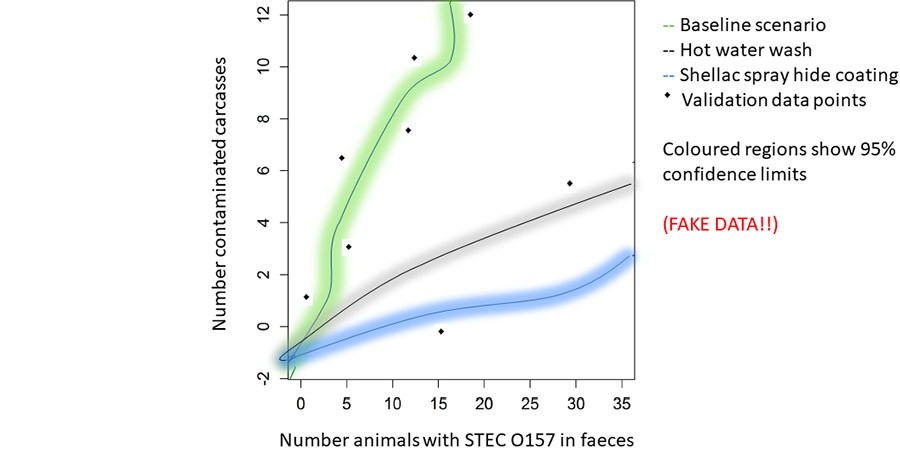Risk assessments are useful tools in evaluating the effect of different interventions within the abattoir. They are particularly useful in situations where traditional interventions studies are likely to be costly or time-consuming, or in situations where there is a large amount of host (or operator) variability. “Farm-to-fork” models are commonly used where the outputs of the model (often human case reductions), are often dependent upon interventions at a much earlier stage of production (often within the farm or abattoir). They also provide an opportunity to compare different interventions, often with less resource requirements than traditional intervention studies. Both qualitative and quantitative risk assessments are commonly used by policy makers. Here, we look at the role of quantitative risk assessments in evaluating the effects of abattoir interventions.
Shiga-toxin producing Escherichia coli O157 (STEC O157) are important foodborne pathogens in humans, causing a spectrum of syndromes ranging from inapparent infection and non-bloody diarrhoea, to haemorrhagic colitis and haemolytic uraemic syndrome (HUS) [1]. Cattle are asymptomatic hosts of STEC O157; the bacteria colonise the gastro-intestinal tract and are shed in faeces [2]. Outbreaks of disease in humans can arise from consumption of contaminated, undercooked beef or unpasteurised dairy products, and it is estimated that between 1982 and 2002 in the US, 21% and 2% of reported STEC O157 foodborne outbreaks were associated with beef and milk respectively [3]. Prevention or reduction of STEC O157 contamination of beef is required to mitigate the risk of human illness, but despite extensive research, many aspects of STEC O157 ecology and epidemiology are still poorly understood and STEC O157 contaminated beef products remain an important cause of foodborne illness [4]. Hides and faeces are common sources of cross-contamination to carcasses during the slaughter processes and both carcass hot water washes and shellac spray cattle hide coatings have been proposed as potential methods to reduce cross-contamination and microbial load.
Structure of the workshop
As quantitative risk assessments are performed using computer software (such as R, matlab or python), it will not be possible for us to produce a full quantitative risk assessment within the timeframe of this workshop. However, we will work through the stages required to produce one, such that if you were to read a risk assessment paper or attend a mathematical modelling course, you should have a better understanding of how these are performed.
During the workshop, we are going to address the risk question:
How many beef carcasses would be preventing from being contaminated with STEC O157, if carcass hot water washes or shellac spray cattle hide coatings were to be used in a beef abattoir, compared to no interventions?
In preparation for the workshop, I recommend spending time thinking about the risk pathway by which you think STEC O157 could transfer from faeces or hides at the farm of origin, to the pre-chill carcass at the abattoir. Be prepared to discuss this amongst the group during the workshop. A well-considered risk pathway will make the risk assessment much easier to perform! Try to avoid being too detailed here, we want to understand the key processes, but will not be able to find data for small steps along the processing line.
During the workshop, you should consider the following questions in your presentation:
- Finalise the risk pathway amongst the group, providing sufficient (but not too much!) detail
- Would you use a stochastic or deterministic model here?
- Where would you get the data from for each stage? What sort of information is available to you as a risk assessor?
- What sources of data could you use for validating your model?
- You decide that you are happy with your data, you run your model and produce the following plot. What would be your interpretation of this data? How reliable do you think the validation data are?

If there is time, then consider the following points:
- How would you use this model to understand the public health risk?
- How would you handle uncertainty in this model?
References:
- Pennington H. Escherichia coli O157. The Lancet. 2013; 376(9750):1428–35.
- Cobbold RN, Hancock DD, Rice DH, Berg J, Stilborn R, Hovde CJ, et al. Rectoanal junction colonization of feedlot cattle by Escherichia coli O157: H7 and its association with supershedders and excretion dynamics. Appl Environ Microbiol. 2007; 73(5):1563–8.
- Rangel JM, Sparling PH, Crowe C, Griffin PM, Swerdlow DL. Epidemiology of Escherichia coli O157:H7 Outbreaks, United States, 1982–2002. Emerg Infect Dis. 2005;( 11):603–9.
- Thomas D, Elliott E. Interventions for preventing diarrhea-associated hemolytic uremic syndrome: systematic review. BMC Public Health. 2013; 13(1):799.
Further reading:
- Smith, B. A., Fazil, A., & Lammerding, A. M. (2013). A risk assessment model for Escherichia coli O157: H7 in ground beef and beef cuts in Canada: Evaluating the effects of interventions. Food Control, 29, 364–381.
- Kosmider RD, Nally P, Simons RR, Brouwer A, Cheung S, Snary EL, Wooldridge M. Attribution of human VTEC O157 infection from meat products: a quantitative risk assessment approach. Risk Anal. 2010 May;30(5):753-65. doi: 10.1111/j.1539-6924.2009.01317.x.
- Dodd CC, Sanderson MW, Jacob ME, Renter DG. Modeling preharvest and harvest interventions for Escherichia coli O157 contamination of beef cattle carcasses. J Food Prot. 2011 Sep;74(9):1422-33.
- Brookes VJ, Jordan D, Davis S, Ward MP, Heller J. Saltelli Global Sensitivity Analysis and Simulation Modelling to Identify Intervention Strategies to Reduce the Prevalence of Escherichia coli O157 Contaminated Beef Carcasses. PLoS One. 2015 Dec 29;10(12):e0146016. doi: 10.1371/journal.pone.0146016.
- FSIS (2001) Risk Assessment of the Public Health Impact of Escherichia coli O157:H7 in Ground Beef.

